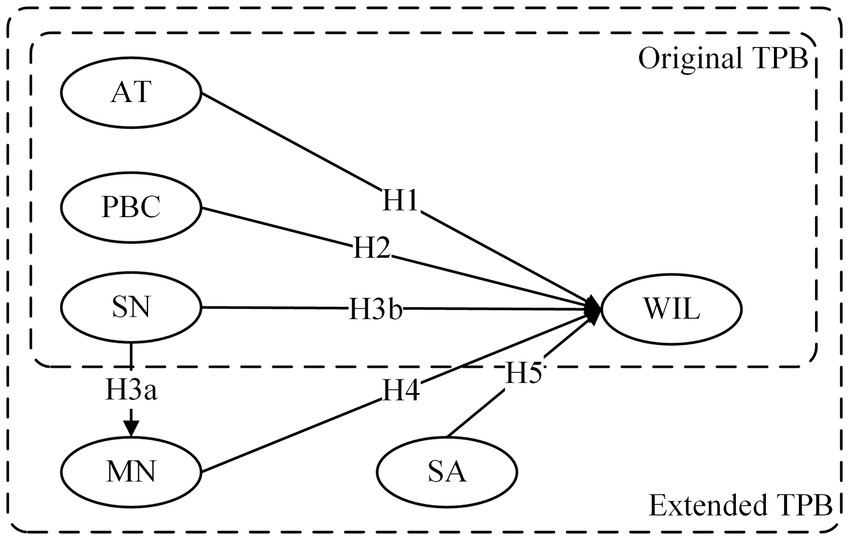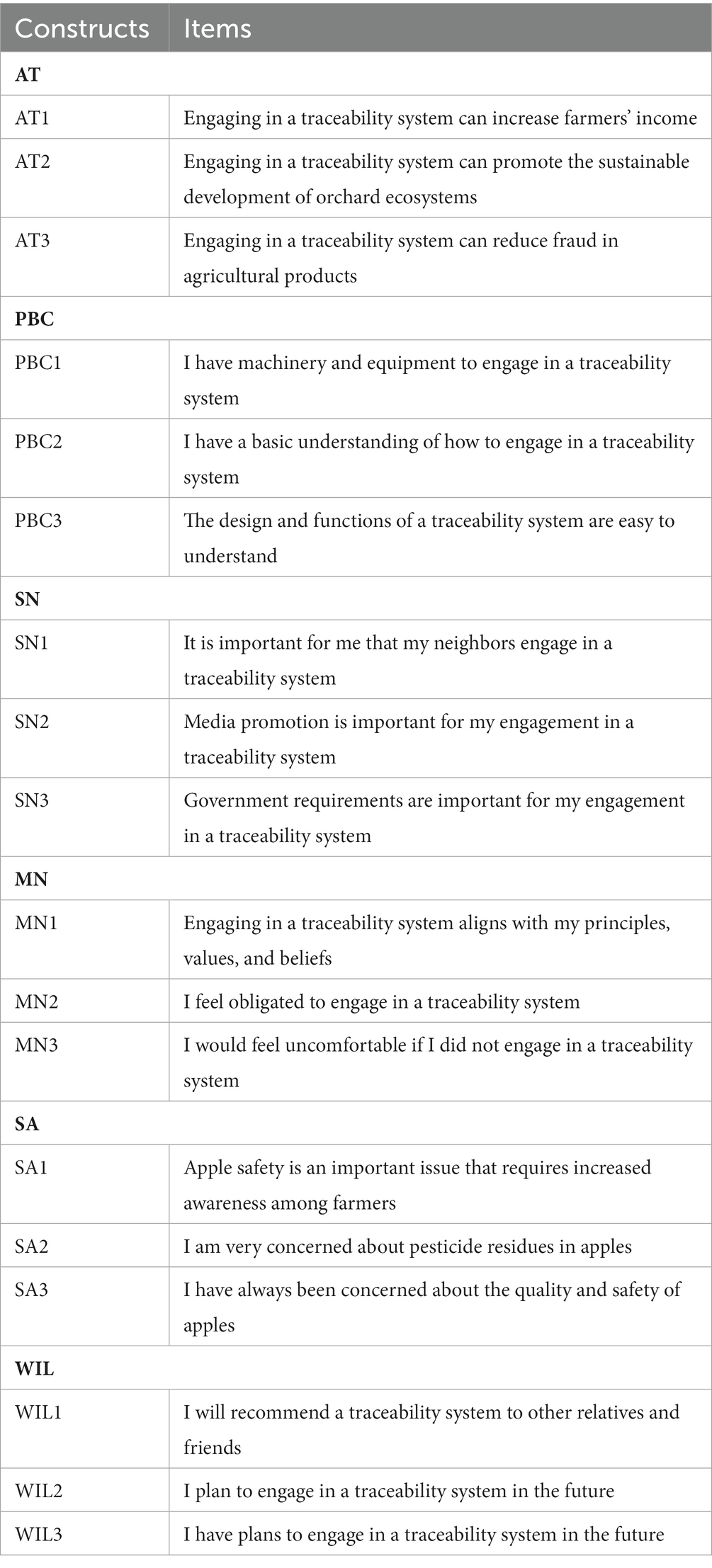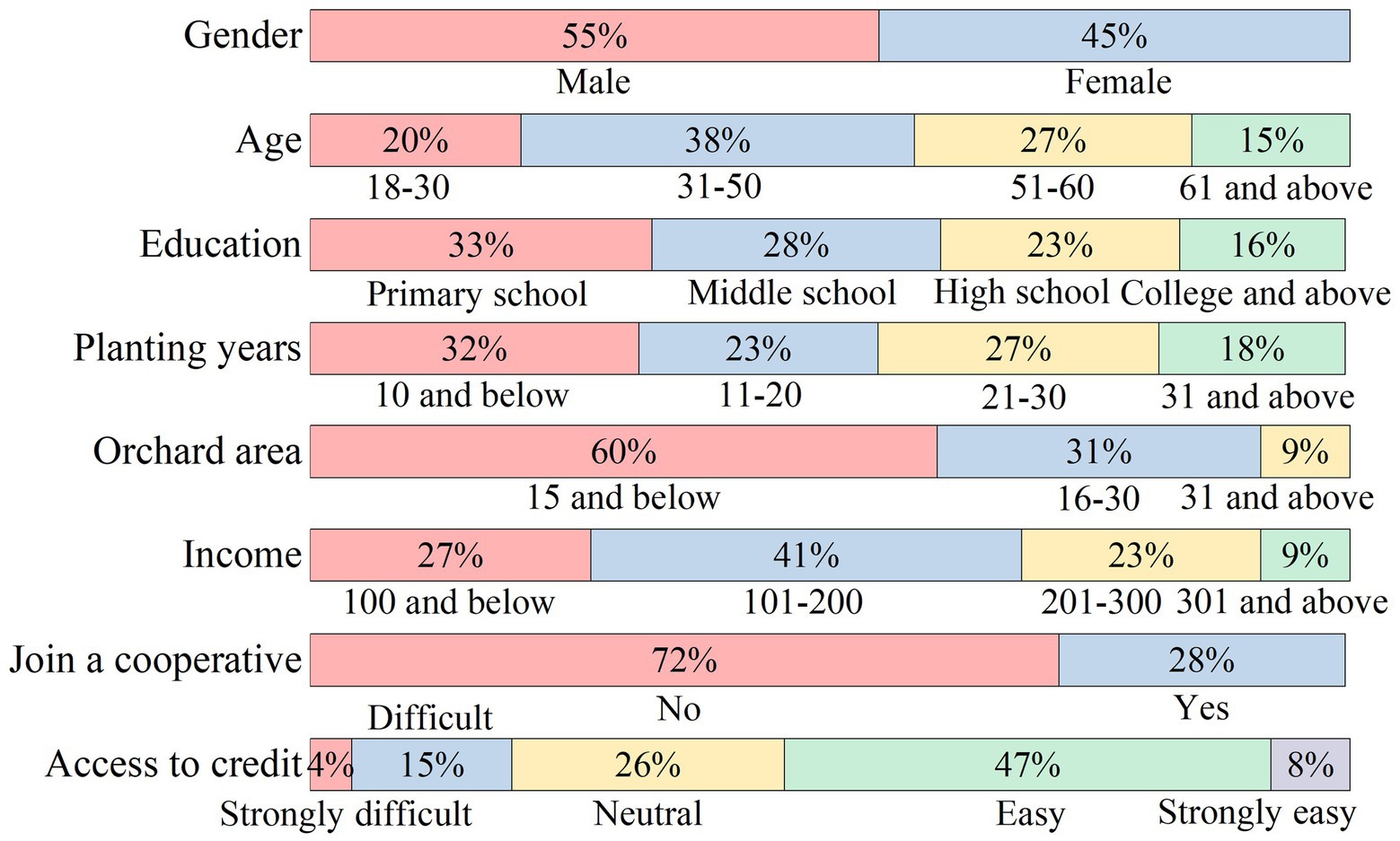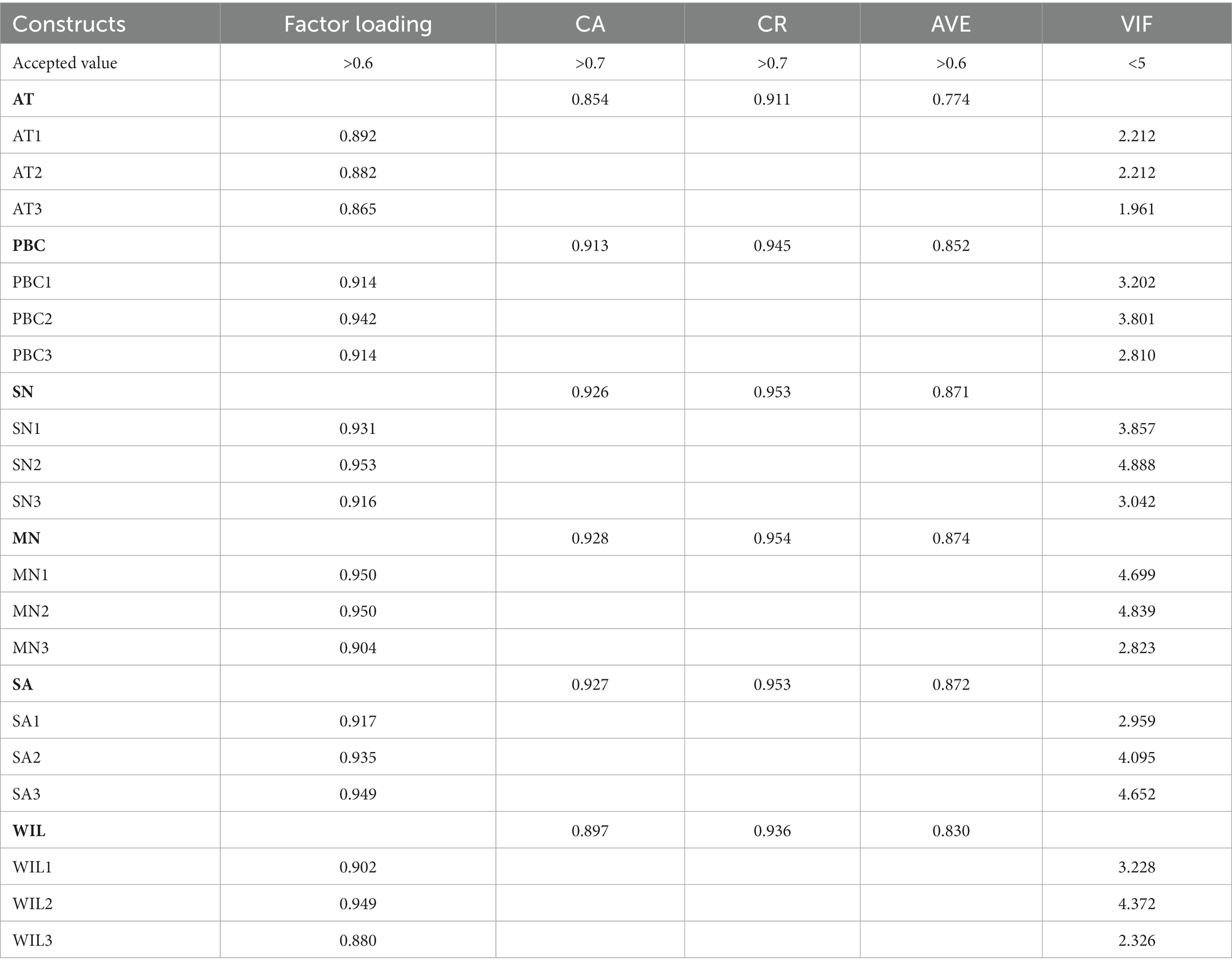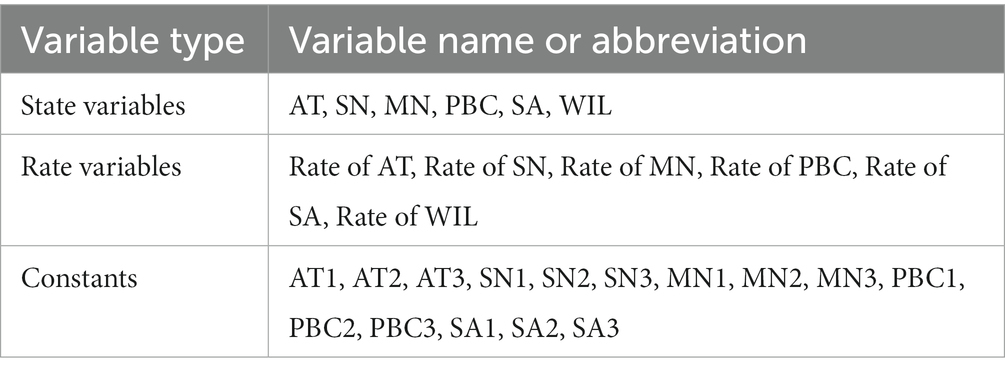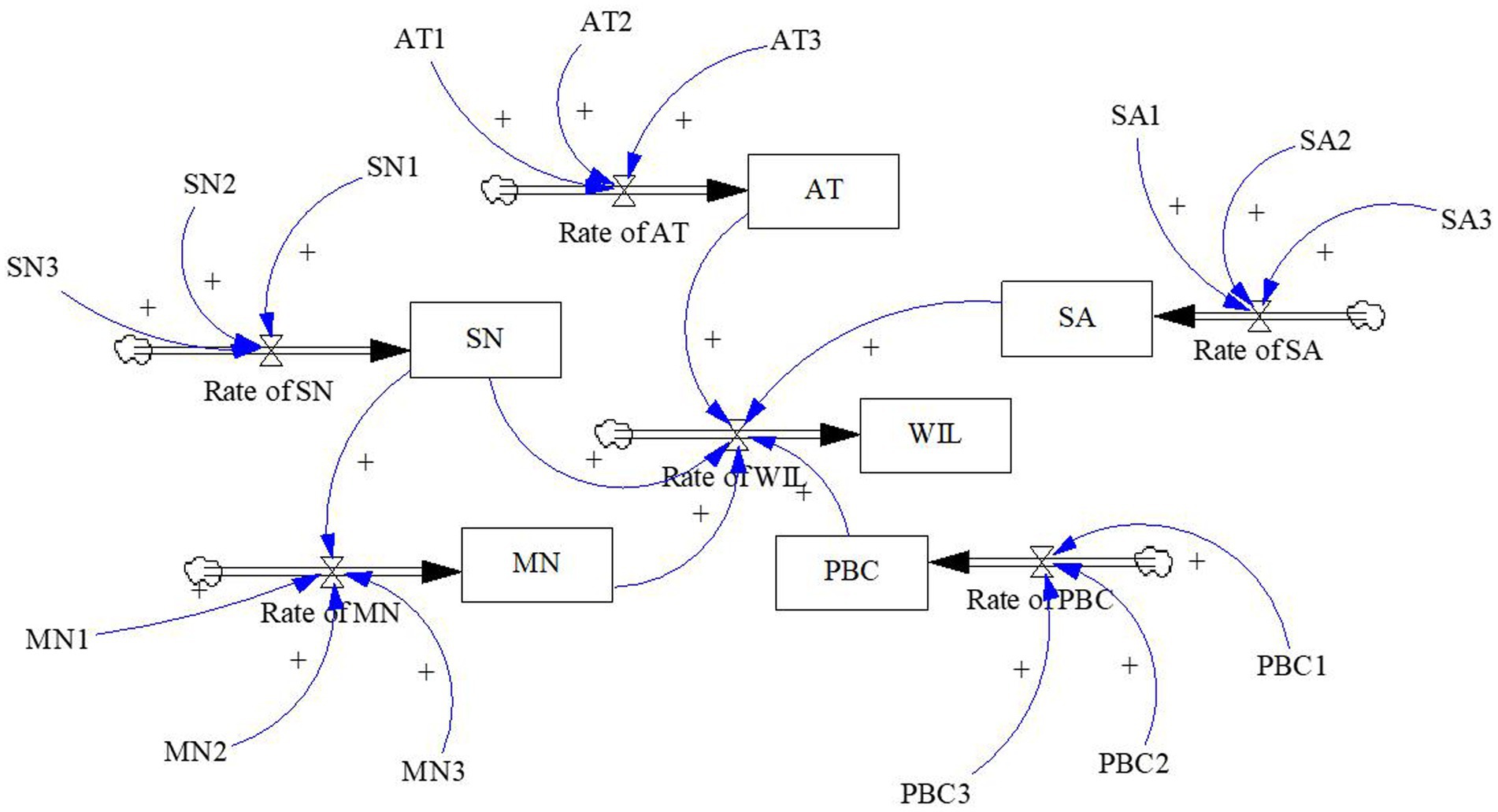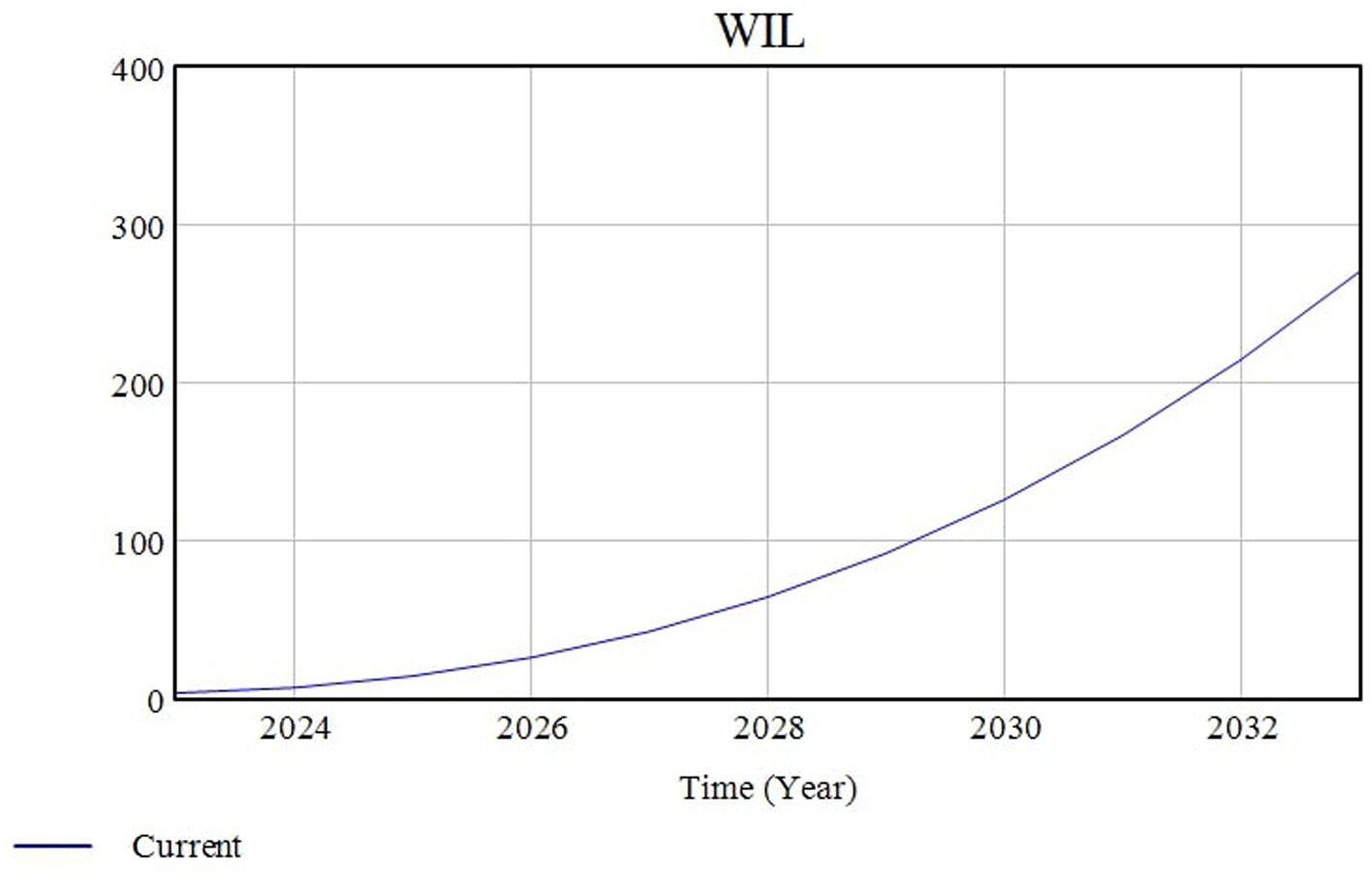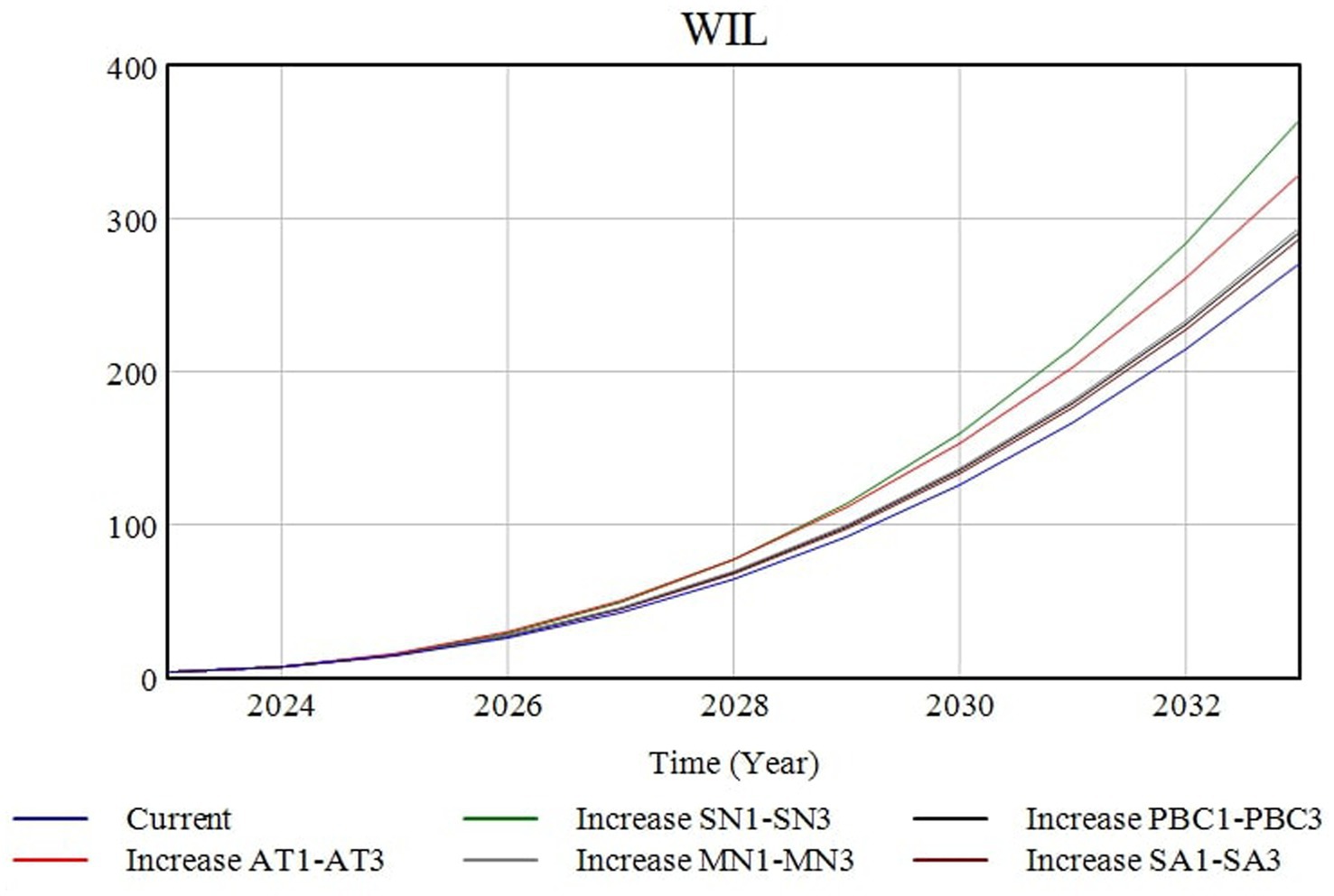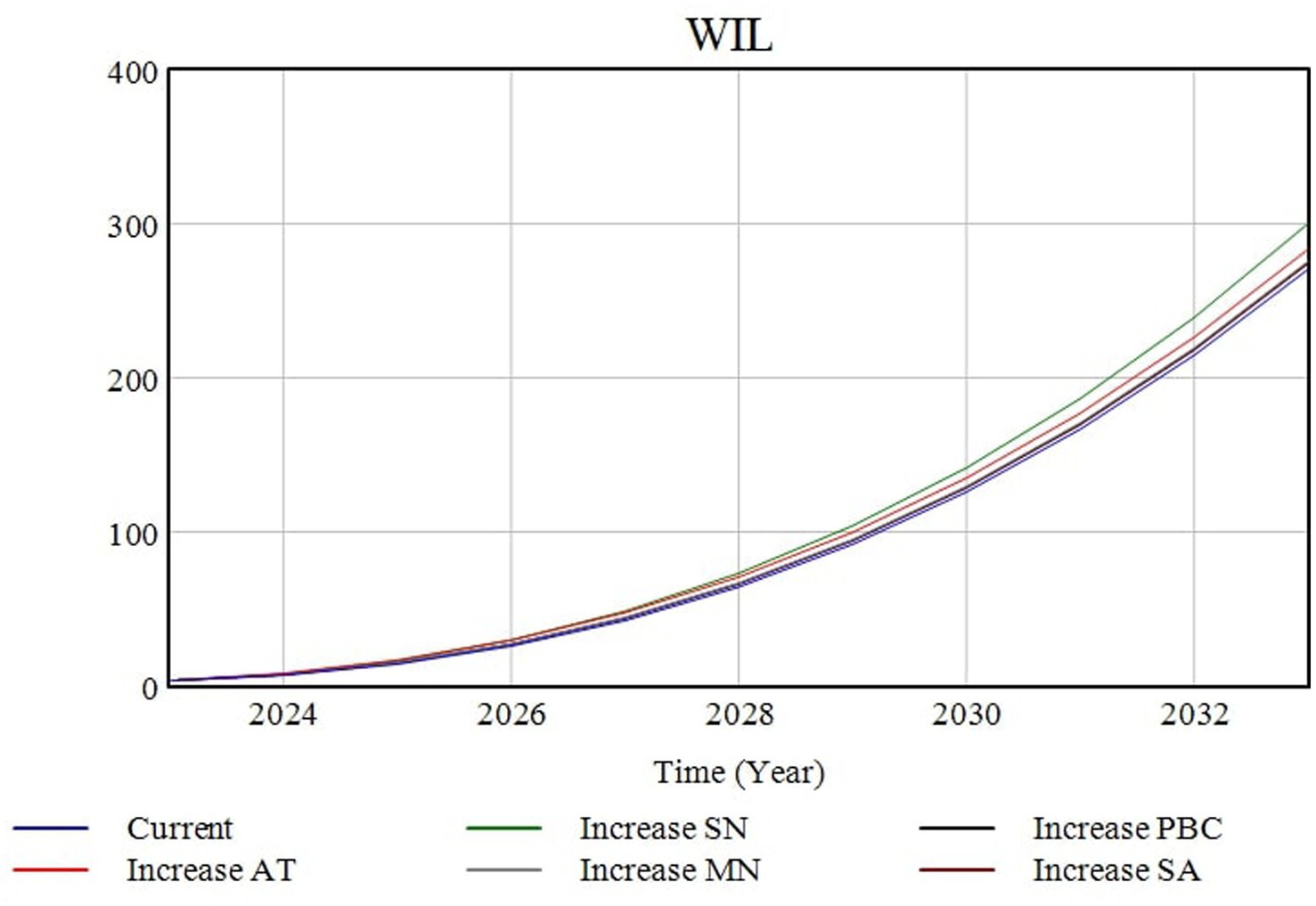- College of Economics & Management, South China Agricultural University, Guangzhou, China
Introduction: The primary objective of this study is to examine the factors that affect farmers’ willingness to engage in traceability systems. Traceability systems are widely promoted as technologies that ensure the quality and safety of agricultural products. However, the participation rate of farmers in developing countries remains low.
Methods: To empirically address this issue, the study analyzed structured interview data from 408 fruit farmers in Henan Province, Central China, using structural equation modeling and system dynamics.
Results: The results indicate that attitude, perceived behavioral control, subjective norms, moral norms, and safety awareness are crucial factors influencing farmers’ willingness to engage. It is particularly noteworthy that system dynamics simulations revealed the significant role of improving attitude and subjective norms in promoting farmers’ willingness. Moreover, subjective norms have a positive influence on moral norms. We also found that gender, education, orchard area, income and access to credit have a significant positive impact on farmers’ willingness to engage.
Discussion: By uncovering the internal decision-making mechanisms behind farmers’ engagement in traceability systems, this study extends the research scope of agricultural technology adoption. These findings can serve as a basis for formulating traceability system policies and interventions in China and other developing countries.
1 Introduction
The quality and safety issues of agricultural products have gained significant global attention (FAO, 2023). As global food trade expands and consumer concerns about food safety grow, traceability systems have emerged as crucial tools for managing agricultural supply chains (Mehannaoui et al., 2022). These systems involve recording and tracking information about the production, processing, transportation, and sale of agricultural products. By doing so, they provide valuable insights into the origin, quality, and safety of the products, thereby enhancing consumer trust and confidence in agricultural products (Huang et al., 2022). Consequently, the establishment of traceability systems has become an important measure to ensure food safety and meet consumer demands.
Currently, many countries and regions have implemented traceability systems to monitor and document the entire process of agricultural products, from cultivation to sale (Zhang et al., 2010; Qian et al., 2020; Rao and Shukla, 2022). However, these traceability systems primarily cater to agricultural enterprises, with limited involvement from farmers, particularly small-scale farmers. Various farmers encounter technological and economic challenges that hinder their full participation in traceability systems. It is important to highlight that farmers, as a fundamental component of the agricultural supply chain, play a crucial role in promoting traceability systems (Li L. et al., 2021). Farmers’ engagement in traceability systems not only enhances the quality and safety of agricultural products but also improves their economic returns and market competitiveness (Huang et al., 2022). Therefore, obtaining a deeper understanding of willingness to engage in traceability systems and the factors that influence it holds great theoretical and practical significance for promoting the construction and development of such systems.
In recent years, the academic community has conducted extensive research into the factor of farmers’ engagement in traceability systems. Firstly, a study examining the preferences of US dairy producers for voluntary traceability systems revealed sensitivity among producers to factors such as price, managing entity, and information requirements (Schulz and Tonsor, 2010). At the same time, perceived control and the meeting the expectations of social/business groups emerged as key factors influencing the engagement behavior of Greece dairy farmers in electronic traceability systems (Pappa et al., 2018). Second, in the context of fruits and vegetables, demographic and economic characteristics were identified as key determinants affecting farmers’ engagement. These characteristics include gender, age, education level, household income, operational area, cooperative organization membership, and the proximity of farmers’ locations to urban areas (Xu et al., 2012; Zhao and Chen, 2012; Li L. et al., 2021). Psychological factors have also been affirmed as influencing farmers’ engagement, including perceived usefulness and awareness (Liao et al., 2011; Li L. et al., 2021). Furthermore, an investigation into the factors influencing the adoption of beef traceability on farms in the state of São Paulo, Brazil, revealed that high levels of human and social capital had a positive impact on decision-making (Vinholis et al., 2017). Pig farmers’ intentions were also influenced by a combination of performance expectancy, effort expectancy, social influence, personal innovation, and perceived risk (Sun et al., 2021). Finally, a review of traceability systems in India found that government standards, policy stability, infrastructure, and farmers’ agricultural practices played a pivotal role in shaping the implementation of traceability systems (Dandage et al., 2017). Agricultural training and government subsidies have also significantly increased farmers’ confidence to engage in traceability systems (Zhao and Chen, 2012).
While there has been considerable progress in previous research on farmers’ engagement in traceability systems, these studies not only neglect to analyze significant variables such as credit accessibility, but also fail to consider critical psychological factors, including moral norms and safety awareness. Meanwhile, the theory of planned behavior (Ajzen, 1991), one of the widely recognized theories to elucidate individual willingness, has not been used in this specific context. Therefore, further research is necessary to provide sufficient evidence on how these variables influence farmers’ willingness to engage in traceability systems. To bridge the gap between literature and reality, we aim to use an extended theory of planned behavior to explain farmers’ willingness to engage in traceability systems and predict their future willingness.
This study has three main implications. Firstly, by introducing moral norms and safety awareness, it extends the theory of planned behavior and delves deeper into the research scope of agricultural technology adoption. This extension promotes a more comprehensive understanding of the factors influencing farmers’ decision-making behavior, particularly in relation to the moral and safety considerations associated with the adoption of new technologies. Secondly, the study uses structural equation modeling and system dynamics analysis to predict future changes in farmers’ willingness to engage in traceability systems, while examining the key factors influencing this willingness. Structural equation modeling, as a multivariate statistical analysis tool, helps to assess the direct and indirect relationships among variables (Ullman and Bentler, 2012). It reveals the significant dynamic factors in the decision-making process of farmers engaged in traceability systems, thus enhancing the comprehension of their behavioral motivations. On the other hand, system dynamics emphasizes modeling the dynamic changes and interrelated effects of systems (Bala et al., 2017). Through the application of system dynamics, we delve deeply into the long-term effects and development trends of farmers’ engagement in traceability systems, providing valuable insights for agricultural decision-makers. Finally, through the analysis of farmers’ personal characteristics and other factors, we further identify the correlation between these factors and farmers’ willingness to engage in traceability systems. This comprehensive analysis contributes to a more thorough understanding of potential differences in willingness to engage in traceability systems among various types of farmers, providing essential guidance for the formulation of targeted policy measures. Overall, this research provides solid theoretical support and a foundation for decision-making, facilitating the rapid promotion of traceability systems in the agricultural sector to ensure the quality and safety of agricultural products.
The article is structured as follows: Section 2 presents the research model and hypotheses. Section 3 presents the study area, data collection, and data analysis methods. Section 4 presents the research findings. Section 5 discusses the findings, offers managerial implications, and suggests future research directions. Finally, Section 6 concludes the article.
2 Research model and hypotheses
The Theory of Planned Behavior (TPB) is a theory that examines individual behavioral intentions and the factors that influence them (Ajzen, 1991). In recent years, TPB and its extended forms have been widely applied in the agricultural field to study farmers’ attitudes and willingness toward different agricultural practices (Gowda et al., 2021; Savari et al., 2023). For example, Elahi et al. (2022) investigated farmers’ willingness to install photovoltaic water pumps, while Li Z. et al. (2023) analyzed the factors influencing farmers’ intentions to adopt green planting technologies. Lou et al. (2021) explored the factors affecting tea farmers’ adoption of pro-green control technology to manage tea pests, and Yang X. et al. (2022) studied the determining factors that influence farmers’ adoption of low-carbon agricultural technologies. These research findings have greatly enhanced our understanding of how farmers perceive and accept new agricultural practices.
While the TPB is widely applicable in understanding farmer behavior, scholars have made enhancements to the original model by incorporating additional variables. These additions aim to improve the stability, explanatory power, and predictive ability of the model regarding farmer behavior (Bagheri et al., 2019; Tama et al., 2021; Yin et al., 2022; Savari et al., 2023). Apart from the existing factors of the theory, the TPB can also include other significant variables that directly or indirectly influence decision-making willingness and behavior (Ajzen, 1991). In light of evidence supported by existing literature, this study aims to introduce two additional variables, namely moral norms and safety awareness, into the original TPB framework. These variables are intended to explore farmers’ willingness to engage in traceability systems. The theoretical model is illustrated in Figure 1.
The original TPB identifies attitude, perceived behavioral control, and subjective norms as the primary factors that shape individual willingness. Attitude (AT) refers to how farmers evaluate the traceability system, which can be positive or negative. Perceived behavioral control (PBC) refers to farmers’ perception of their control over their role in the system and how easy it is to engage. Subjective norms (SN) include the social pressures farmers experience when deciding whether to engage in traceability systems, including expectations from neighbors, media, and government officials. Willingness (WIL) reflects the extent to which farmers actively try to engage in traceability systems. Previous studies have confirmed that AT plays the most significant role in farmers’ adoption of agricultural technology (Yang X. et al., 2022). Furthermore, SN greatly influence farmers’ willingness to engage in agricultural practices (Daxini et al., 2019). This is because individuals often strive to meet the expectations of others when influenced by social factors (Gowda et al., 2021). Moreover, farmers may encounter various difficulties when engaging in agricultural practices, including internal psychological challenges such as lack of knowledge and skills, as well as inadequate external resources. If these challenges cannot be overcome, farmers may lose motivation and become unwilling to actively engage in agricultural practices (Rezaei et al., 2019).
Moral norms (MN) refers to the moral emotions and obligations that farmers encounter when engaging in traceability systems. MN plays a vital role in farmers’ acceptance of agricultural technologies (Gowda et al., 2021). Several relevant studies have shown that individuals’ moral commitments have a significant impact on reducing unethical behavior (Bozorgparvar et al., 2018; Bagheri et al., 2019; Ataei et al., 2021). Upholding high moral standards encourages individuals to adopt appropriate social behavior (Fornara et al., 2016). Moreover, SN have a crucial influence on the internalization of individual beliefs, meaning that SN greatly affect MN (Rezaei et al., 2019; Wang et al., 2023).
Safety awareness (SA) primarily refers to the extent to which farmers prioritize the quality and safety of agricultural products. Engagement in traceability systems can effectively discourage unsafe production practices by farmers, ensuring that they adhere to traceability standards when growing agricultural products (Huang et al., 2022). Pesticides and fertilizers play a crucial role in the production of fresh agricultural products, but the presence of pesticide residues can potentially impact the safety of these products. Farmers may face the risk of lower sales contract prices due to pesticide residues, especially those who already have lower income from selling their crops (Wang et al., 2017). Research has indicated that farmers’ awareness of pesticide residues tends to increase over time, influencing their adoption of environmentally friendly pesticide use practices (Li H. et al., 2023). In addition, a survey conducted among new farmers in China revealed that concerns about food safety can serve as motivation for farmers to provide safer and higher-quality fresh agricultural products, meeting the demands of consumers (Yang Z. et al., 2022). Consequently, this will further enhance farmers’ willingness to engage in traceability systems.
Based on the theoretical analysis and literature review discussed above, we propose the following hypotheses:
H1: AT will have a positive influence on WIL.
H2: PBC will have a positive influence on WIL.
H3a: SN will have a positive influence on MN.
H3b: SN will have a positive influence on WIL.
H4: MN will have a positive influence on WIL.
H5: SA will have a positive influence on WIL.
3 Methodology
3.1 Study area
The selected research area is Sanmenxia City, located in Henan Province, Central China. It is situated between 33°31′24″N to 35°05′48″N latitude and 110°21′42″E to 112°01′24″E longitude. The average altitude of the area ranges from 300 to 1,500 meters. With an average annual temperature of 14.2°C and annual rainfall between 400 and 700 millimeters, it offers favorable conditions for agricultural cultivation and fruit production. Thus, it is an ideal location for agricultural research. Despite its potential, the region is primarily operated by small-scale farmers, which poses challenges in raising the prices of their high-quality agricultural products. In addition, although the local agricultural department has developed a traceability system, most farmers have not yet engaged, possibly because they have a limited understanding of the system’s mechanisms, how to engage, and the actual benefits of engagement. Finally, local apples have been identified as geographical indication agricultural products and should be managed strictly in accordance with the requirements of agricultural product quality and safety legislation to prevent the misuse and weakening of the regional brand. Therefore, studying the engagement of farmers in traceability systems becomes crucial, making this area an important case study.
3.2 Questionnaire design and data collection
Before officially distributing the questionnaire, we performed several tasks to ensure its quality. First, we conducted a comprehensive review of the relevant literature and made several visits to the research area. This allowed us to gain a thorough understanding of the background and current status of the field. With this knowledge in mind, we then designed the structure and content of the questionnaire. All measurements have been adapted from previous literature. To ensure the accuracy of the questionnaire, we sought validation from professors and doctoral students in the field of agriculture. They carefully examined the concepts of each measurement item to confirm its relevance and accuracy within the agricultural domain. We also conducted a pilot study to assess the applicability of the questionnaire. During the pilot study, participants completed the questionnaire and provided feedback. If any items were found to be difficult to understand, we made necessary wording modifications to improve clarity.
The questionnaire consists of two parts. First, participants are asked to provide selected demographic characteristics, including gender, age, education, planting years, orchard area, etc. Following this, Likert scales are used to measure various latent variables such as AT, PBC, SN, MN, SA, and WIL. The scales range from 1 (strongly disagree) to 5 (strongly agree). When developing a multidimensional scale, it is essential to ensure that each factor has at least three items with significant loadings (Raubenheimer, 2004). This ensures the reliability and validity of the measurement. Therefore, we carefully followed this principle in the questionnaire design, guaranteeing that each latent variable contains a minimum of three relevant items (Table 1).
To ensure a representative sample of the whole population, we used random sampling for distributing questionnaires. Following the guidelines provided by Krejcie and Morgan (1970) and Hair et al. (2010), the recommended sample size should be at least 10 times the number of questionnaire items. To meet the minimum sample size required for empirical analysis, a total of 500 questionnaires were distributed, and face-to-face interviews were conducted with fruit farmers aged 18 and above. During the survey, farmers who were able to read and understand the questionnaire completed it themselves. For those unable to read or write, we conducted interviews and completed the questionnaire based on their responses. After removing questionnaires with missing variables and invalid data, we obtained 408 valid questionnaires, resulting in a valid response rate of 81.6%.
Figure 2 presents the demographic and economic characteristics of the farmers. Male farmers accounted for 55% of the sample, while female farmers accounted for 45%. Two-fifths of the farmers fell within the age range of 31–50. In terms of education, one-third of the farmers had completed primary education. Over half of the farmers had been engaged in agriculture for 11 to 30 years. Regarding orchard area, three-fifths of the farmers owned less than 15 mu of land (1 hectare = 15 mu), indicating that they primarily belonged to the category of small-scale farmers. More than a quarter of households have an income of less than 100 thousand CNY, and nearly three-quarters of farmers have not yet joined cooperatives. However, about one-fifth of the farmers find it extremely difficult to obtain credit.
3.3 Data analysis
The data analysis consists of three main steps. The first step involves the use of structural equation modeling (SEM) for theoretical modeling. SEM consists of two basic models: the measurement model and the structural model. The measurement model explains the linear relationship between latent variables and observed variables, while the structural model is used to describe the linear relationship between latent independent variables and latent dependent variables (Hair et al., 2012). This initial step aims to explore the relationships between variables by creating mathematical models and providing structured explanations and validations for the data. The second step builds on the results obtained from SEM and employs Vensim PLE software for system dynamics (SD) modeling of farmers’ willingness. The process of SD modeling involves several stages. First, the problem is identified. Second, dynamic hypotheses are formulated by proposing assumptions about changes in farmers’ willingness based on existing theories and literature. Next, the basic structure of causal loops is established by creating causal loop diagrams that describe the interactions among variables. Then, these causal loop diagrams are converted into SD flowcharts to visualize the dynamic nature of causal relationships. Finally, the SD flowchart is implemented in Vensim software to simulate and analyze the behavior of the system (Bala et al., 2017). This step enables a deeper understanding of the complex relationships between farmers’ willingness to engage in traceability systems and the influencing factors. Finally, we used a logit regression model to explore the impact of demographic and economic characteristics on farmers’ willingness to engage in traceability systems. We considered the latent variable “willingness” as the dependent variable and calculated its average. For farmers indicating strong agreement and agreement, we assigned a value of 1, while assigning a value of 0 to other farmers. At the same time, we used the demographic and economic characteristics of the farmers as independent variables to develop a binary logit regression model. Logit regression analysis is crucial for exploring the needs and motivations of different groups of farmers and for conducting risk assessments. By thoroughly analyzing the demographic and economic conditions of farmers, it helps to facilitate the development of effective policies to enhance farmers’ engagement in traceability systems.
4 Results
4.1 SEM analysis
4.1.1 Measurement model
We use confirmatory factor analysis to evaluate the validity and reliability of the measurement model, which includes internal consistency, convergent validity, and discriminant validity. According to the results in Table 2, the Cronbach’s alpha (CA) and composite reliability (CR) values exceed 0.7, indicating satisfactory internal consistency of the data. All item factor loadings are above 0.7, and the average variance extracted (AVE) values for all variables are above 0.6, indicating a strong convergent validity of the model (Hair et al., 2010). Furthermore, the variance inflation factor (VIF) values for each item range from 1.961 to 4.888, which is below the threshold of 5, indicating the absence of significant multicollinearity problems in the model (Hair et al., 2017). Lastly, the square root of the AVE exceeds its correlation coefficients (Table 3), indicating sufficient discriminant validity of the model (Fornell and Larcker, 1981). Therefore, the measurement model has successfully passed the relevant tests and is now ready for structural model analysis.
4.1.2 Structural model
Table 4 presents the results of the structural model, revealing the impact of different factors on farmers’ willingness to engage in traceability systems. The results support all the hypotheses. Firstly, AT (β = 0.358, p < 0.01), PBC (β = 0.162, p < 0.01), and SN (β = 0.228, p < 0.01) have a significant and positive impact on WIL, confirming H1, H2, and H3b, respectively. Moreover, MN (β = 0.169, p < 0.01) and SA (β = 0.085, p < 0.05) also have a significant positive predictive effect on WIL, confirming H4 and H5, respectively. In addition, the influence coefficient of SN on MN is 0.809 (p < 0.01), further confirming H3a.
4.2 SD analysis
4.2.1 The variable set in SD model
Based on the analysis results from SEM and considering the characteristics of SD simulation, we meticulously classified the variables involved into three types: state variables, rate variables, and constants (Table 5).
4.2.2 SD model for farmers’ willingness
Using the variable set designed in Table 5 and the SEM results, we constructed an SD model of farmers’ willingness using Vensim PLE software (see Figure 3). To ensure the effectiveness of the model, we conducted a running test, which confirmed that the model was functioning correctly, displaying the message “Model is OK.”
4.2.3 Simulation parameters
For this study, we defined the production cycle of farmers as 1 year and simulated scenarios from 2023 to 2033 within this timeframe. The simulation time step was set to 1 year. By calculating path coefficients, which measure the influence relationships between latent variables, we established equations among relevant variables. To determine the initial values of constants and state variables, we used data gathered from a questionnaire survey. The initial values of the 15 constants were set to match the values of the corresponding indicator variables. Similarly, the initial values of AT, SN, MN, PBC, SA, and WIL were determined as the weighted sum of their corresponding indicator variables.
4.2.4 SD simulation
The primary objective of the dynamic simulation is to predict farmers’ willingness to engage in traceability systems and to examine the impact of different factors on their willingness. Figure 4 shows the simulation results of farmers’ willingness in the initial state. Overall, there is an upward trend in farmers’ willingness. In particular, prior to 2026, the growth rate remains relatively steady, but after that, it experiences a rapid increase.
Figure 5 shows the simulation results of farmers’ willingness after modifying the constants. We specifically increased “AT1-AT3,” “SN1-SN3,” “MN1-MN3,” “PBC1-PBC3,” and “SA1-SA3” by 100% each. By analyzing the influence of observed variables on farmers’ willingness, we can rank them as follows: “SN1-SN3,” “AT1-AT3,” “MN1-MN3,” “PBC1-PBC3,” and “SA1-SA3.” It is worth noting that the impact of “SN1-SN3” and “AT1-AT3” on farmers’ willingness far outweighs the influence of other observed variables.
Figure 6 demonstrates the simulation results of farmers’ willingness after modifying the state variables. We have individually increased “AT,” “SN,” “MN,” “PBC,” and “SA” by 100%. In terms of the degree of influence of state variables on farmers’ willingness, they can be ranked as follows: “SN,” “AT,” “MN,” “PBC,” and “SA.” Similarly, it is important to emphasize that the influence of “SN” and “AT” is significantly greater compared to other state variables.
4.3 Logit regression results
The logit regression results in Table 6 indicate that five variables have a significant and positive effect on farmers’ willingness to engage in traceability systems. Specifically, gender, education, and access to credit have a significant impact on farmers’ willingness at the 1% level, while orchard area shows a significant effect at the 5% level, and income demonstrates a significant effect at the 10% level. This research highlights the key role of gender, education, orchard area, income, and access to credit in affecting farmers’ willingness to engage in traceability systems. A deep understanding of these factors can help to design more effective policies that provide targeted support to farmers, thereby promoting the widespread adoption of traceability systems.
5 Discussions and implications
5.1 Discussions
The findings of this study provide valuable insights. Firstly, it confirms the effectiveness of the original TPB in understanding farmers’ willingness. Farmers’ willingness is influenced by AT, SN, and PBC. This finding is consistent with Ajzen’s (1991) research, which concluded that AT, SN, and PBC accurately predict various behavioral willingness. Secondly, the study confirms the importance of MN and SA as influential factors in farmers’ willingness. This highlights the need to extend the TPB to include these additional factors. Moreover, the SD results indicate that SN and AT are crucial for enhancing farmers’ willingness in the future, compared to other factors.
Among the various factors considered, attitude stands out as the most influential aspect affecting farmers’ willingness to engage in traceability systems. In other words, how farmers perceive the traceability system plays a crucial role in shaping their willingness to engage. This finding is further supported by the results of the SD simulation. Ajzen and Cote (2008) argue that attitude serves as the most reliable predictor of individual behavior. In fact, research by Rezaei et al. (2018) shows that when farmers maintain a positive attitude toward on-farm food safety practices, they are noticeably more inclined to actively engage in such practices. As a result, it has been consistently observed that farmers who have a positive attitude toward the traceability system exhibit significantly higher psychological readiness to engage, which has been corroborated by empirical surveys. Farmers generally believe that the traceability system helps to improve the quality and safety standards of agricultural products, ultimately increasing consumer confidence in these products. They also recognize that active engagement in traceability systems can increase the market competitiveness of agricultural products and broaden sales channels, leading to greater economic returns. Therefore, prioritizing efforts to enhance farmers’ attitudes toward the traceability system should be a key focus for future policy considerations.
Farmers’ willingness to engage in traceability systems is strongly influenced by SN. During the initial stages of adopting agricultural technologies, farmers are particularly influenced by key individuals who already use such technologies in their own farming practices (Ulhaq et al., 2022). Gowda et al. (2021) also affirmed the significant impact of family members, friends, relatives, progressive farmers, and agricultural experts on farmers’ willingness to engage. This influence is especially pronounced among Chinese farmers, given the cultural emphasis on collectivism, where group behavior holds greater importance (Wang et al., 2020). In addition, Chinese farmers typically have lower education levels and limited knowledge of professional agricultural technology (Li L. et al., 2021; Nong et al., 2021). They rely heavily on observing and learning from others to acquire production skills, thereby placing value on the practices of their peers. In the actual research, despite the local government’s establishment of relevant incentive measures and promotion of the traceability system, we found that the number of farmers involved is relatively limited. Most farmers have adopted a wait-and-see attitude and have indicated that they are influenced by other farmers. If their neighbors engage in traceability systems, they would follow suit. Therefore, it is crucial to leverage SN in guiding farmers’ active engagement in traceability systems.
PBC plays a crucial role in influencing farmers’ willingness to engage in traceability systems. Essentially, the stronger the farmers’ perceived control over their actions, the more likely they are to be willing to engage in traceability systems. However, if farmers lack the necessary knowledge and resources and perceive significant barriers to engagement, their willingness to engage may decrease. This finding aligns with previous research conducted by Rezaei et al. (2018), Li F. et al. (2021), and Tama et al. (2021), all of whom identified PBC as a predictive factor for farmers’ engagement in agricultural practices. Furthermore, as farmers’ PBC increases, they tend to experience greater motivation and confidence (Brown et al., 2000; Yin et al., 2022). In addition, Li Z. et al. (2023) also noted that farmers with a higher sense of self-efficacy perceive themselves as capable and confident in adopting new technologies and practices in agricultural production, which, in turn, leads to a higher willingness to engage. In the actual investigation, we discovered that local farmers have a limited knowledge of the traceability system and lack the required hardware and software, which create technological barriers for their engagement. Although the local government has made efforts, the effectiveness of the provided training has been limited. Therefore, they need support from the government or technology providers to improve their capacity to engage.
There is a strong correlation between MN and WIL. This relationship is supported by the studies conducted by Ataei et al. (2021), Tran-Nam and Tiet (2022), and Savari et al. (2023). These findings suggest that an individual’s sense of moral obligation plays a crucial role in influencing farmers’ decisions to engage in traceability systems. According to Gowda et al. (2021), farmers who prioritize consumer health are more likely to understand the social demands and consumer sentiments associated with traceability. Furthermore, an individual’s moral standards can generate feelings of anticipated pride or guilt in relation to their agricultural practices. These emotions, in turn, may impact their actual behavior and willingness to engage (Rezaei et al., 2019). Given that engagement in traceability systems is commonly perceived as an altruistic act with significant moral implications, the moral standards held by farmers greatly influence their willingness to engage. Despite the social and cultural context of rural areas in China, where farmers typically adhere to altruistic principles and prioritize consumer health, policymakers can effectively emphasize the moral obligations that farmers have when engaging in traceability systems.
We found a strong positive correlation between SA and WIL. In our survey, we observed that the majority of farmers had a high level of safety awareness. They clearly expressed their concern about exceeding pesticide residue standards in agricultural products, as it could result in significant quality issues and negatively affect their reputation and income. Furthermore, the local government has gradually improved the quality inspection of agricultural products and imposed relatively strict regulatory constraints on products that do not meet the standards. Therefore, we believe that by enhancing farmers’ safety awareness, we can not only strengthen their willingness to engage in traceability systems but also positively impact the overall quality of agricultural products and the economic interests of farmers.
The willingness of farmers to engage in traceability systems is strongly influenced by demographic and economic factors. Research suggests that, compared to females, males are more inclined to engage in traceability systems, mainly because they generally have greater access to new knowledge (Li L. et al., 2021), making them more receptive to new technologies. Meanwhile, farmers with higher education levels also tend to engage in traceability systems. This is because well-educated farmers are better able to understand and adapt to new technological tools (Monteiro and Caswell, 2009), indicating a greater willingness to learn and actively engage in traceability systems. In addition, farmers with larger orchards express a greater willingness to engage in traceability systems. Previous research has confirmed that farm size is an important factor in explaining technology adoption (Vinholis et al., 2017). Owning a larger orchard means that farmers have a greater economic stake in agricultural production, which not only increases their capacity to adopt agricultural technologies, but also strengthens their ability to manage risk. Income also has a positive effect on farmers’ willingness to engage. Higher income levels mean that farmers have more economic resources (Xu et al., 2012), making it easier to invest in traceability systems. Finally, access to credit also makes it easier for farmers to secure the funds required for investing in agricultural technologies and equipment, thereby enhancing the feasibility of their engagement in traceability systems.
Although the research findings pertain to China, it has universal relevance and can be applied to other countries, particularly developing countries. Researchers can validate these findings through on-site investigations in rural areas of their respective regions, enabling them to better comprehend their own country’s farmers’ willingness to engage in traceability systems. Due to the early stage of promotion of China’s traceability system, the main focus is on promoting cash crops, such as fruits and vegetables. Relevant regulations also focus on monitoring these types of farmers. Most farmers have only a basic understanding of the system, lacking specific knowledge about its technological intricacies. Therefore, it seems appropriate at this stage to conduct an initial exploration and simulation of farmers’ willingness to engage in traceability systems, using an extended TPB model, coupled with SEM and SD methods. This research is in line with the current circumstances. In future research, based on the actual implementation of the traceability system, we plan to review the selection of research models and associated assumptions, conducting comparative analyses in multiple locations to better assess farmers’ attitudes and behaviors.
5.2 Managerial implications
The research findings provide valuable insights for policymakers. Firstly, it’s crucial to raise public awareness through diverse channels, including broadcasting, television, and the Internet, to spread information about the traceability system to farmers, especially female farmers, and improve their understanding of the system. Secondly, the government and technology providers should provide specialized technical training on the traceability system for farmers with lower educational levels, enabling them to understand how the system works and how to engage. At the same time, leveraging the role of larger-scale and current participants in the traceability system is vital to strengthen their influence on small-scale and ordinary farmers. It is also important to organize promotional campaigns on the quality and safety of agricultural products, educating farmers about food safety and risk awareness, thereby enhancing their comprehension of agricultural product safety. In addition, the government can introduce incentive measures to encourage low-income farmers to engage in traceability systems, including tax incentives, subsidies, or direct rewards, to increase their enthusiasm. Finally, providing credit support is also a crucial step in enhancing farmers’ capacity to engage in traceability systems.
6 Conclusion
Farmers’ engagement in traceability systems is crucial for ensuring the quality and safety of agricultural products. This study is based on the extended TPB and uses SEM and SD to model the determining factors of farmers’ willingness to engage in traceability systems. The research findings reveal that, in addition to attitude, perceived behavioral control, and subjective norms, moral norms and safety awareness also significantly influence farmers’ willingness. Therefore, it is recommended to incorporate moral norms and safety awareness as variables when predicting farmers’ engagement in traceability systems within the framework of the TPB. It is noteworthy that subjective norms and attitudes play a crucial role in increasing farmers’ willingness. Furthermore, we observed that gender, education, orchard area, income, and access to credit positively impact farmers’ willingness. These findings not only provide a fresh perspective for a deeper comprehension of farmers’ willingness to engage in traceability systems, but also help policymakers to design more precise promotion strategies, thus facilitating the widespread application of the traceability system and promoting sustainable agricultural development.
Data availability statement
The original contributions presented in the study are included in the article/supplementary material, further inquiries can be directed to the corresponding author.
Ethics statement
Ethical review and approval was not required for the study on human participants in accordance with the local legislation and institutional requirements. Written informed consent from the participants was not required to participate in this study in accordance with the national legislation and the institutional requirements.
Author contributions
YH: Conceptualization, Data curation, Formal Analysis, Methodology, Software, Writing – original draft, Investigation. SF: Funding acquisition, Writing – review & editing.
Funding
This research was supported by the Guangdong Planning Office of Philosophy and Social Science (Grant No. D22CGL18) and 'Overseas Famous Scholars' Project of Guangdong Province in 2022.
Acknowledgments
We appreciate sincerely the reviewers and the Associate Editor, Travis Idol, for their careful reading of the manuscript and their constructive and insightful comments that helped to improve this manuscript.
Conflict of interest
The authors declare that the research was conducted in the absence of any commercial or financial relationships that could be construed as a potential conflict of interest.
Publisher’s note
All claims expressed in this article are solely those of the authors and do not necessarily represent those of their affiliated organizations, or those of the publisher, the editors and the reviewers. Any product that may be evaluated in this article, or claim that may be made by its manufacturer, is not guaranteed or endorsed by the publisher.
References
Ajzen, I. (1991). The theory of planned behavior. Organ. Behav. Hum. Decis. Process. 50, 179–211. doi: 10.1016/0749-5978(91)90020-T
Ajzen, I., and Cote, N. G. (2008). Attitudes and the prediction of behavior. Attitudes and attitude change, Vol. 13. New York: Psychology Press.
Ataei, P., Gholamrezai, S., Movahedi, R., and Aliabadi, V. (2021). An analysis of farmers’ intention to use green pesticides: the application of the extended theory of planned behavior and health belief model. J. Rural. Stud. 81, 374–384. doi: 10.1016/j.jrurstud.2020.11.003
Bagheri, A., Bondori, A., Allahyari, M. S., and Damalas, C. A. (2019). Modeling farmers’ intention to use pesticides: an expanded version of the theory of planned behavior. J. Environ. Manag. 248:109291. doi: 10.1016/j.jenvman.2019.109291
Bala, B. K., Arshad, F. M., and Noh, K. M. (2017). System dynamics. Model Simulat :274. doi: 10.1007/978-981-10-2045-2
Bozorgparvar, E., Yazdanpanah, M., Forouzani, M., and Khosravipour, B. (2018). Cleaner and greener livestock production: appraising producers' perceptions regarding renewable energy in Iran. J. Clean. Prod. 203, 769–776. doi: 10.1016/j.jclepro.2018.08.280
Brown, K. A., Willis, P. G., and Prussia, G. E. (2000). Predicting safe employee behavior in the steel industry: development and test of a sociotechnical model. J. Oper. Manag. 18, 445–465. doi: 10.1016/S0272-6963(00)00033-4
Dandage, K., Badia-Melis, R., and Ruiz-García, L. (2017). Indian perspective in food traceability: a review. Food Control 71, 217–227. doi: 10.1016/j.foodcont.2016.07.005
Daxini, A., Ryan, M., O’Donoghue, C., and Barnes, A. P. (2019). Understanding farmers’ intentions to follow a nutrient management plan using the theory of planned behaviour. Land Use Policy 85, 428–437. doi: 10.1016/j.landusepol.2019.04.002
Elahi, E., Khalid, Z., and Zhang, Z. (2022). Understanding farmers’ intention and willingness to install renewable energy technology: a solution to reduce the environmental emissions of agriculture. Appl. Energy 309:118459. doi: 10.1016/j.apenergy.2021.118459
FAO. (2023). FAO strategic priorities for food safety within the FAO strategic framework 2022–2031. Rome: FAO.
Fornara, F., Pattitoni, P., Mura, M., and Strazzera, E. (2016). Predicting intention to improve household energy efficiency: the role of value-belief-norm theory, normative and informational influence, and specific attitude. J. Environ. Psychol. 45, 1–10. doi: 10.1016/j.jenvp.2015.11.001
Fornell, C., and Larcker, D. F. (1981). Structural equation models with unobservable variables and measurement error: algebra and statistics. J. Mark. Res. 18, 382–388. doi: 10.1177/002224378101800313
Gowda, B., Sendhil, R., Adak, T., Raghu, S., Patil, N., Mahendiran, A., et al. (2021). Determinants of rice farmers’ intention to use pesticides in eastern India: application of an extended version of the planned behavior theory. Sustain Product Consum 26, 814–823. doi: 10.1016/j.spc.2020.12.036
Hair, J. F., Hult, G. T. M., Ringle, C. M., Sarstedt, M., and Thiele, K. O. (2017). Mirror, mirror on the wall: a comparative evaluation of composite-based structural equation modeling methods. J. Acad. Mark. Sci. 45, 616–632. doi: 10.1007/s11747-017-0517-x
Hair, J. F. Jr., Black, W. C., Babin, B. J., and Anderson, R. E. (2010). “Multivariate data analysis” in Multivariate data analysis, 785.
Hair, J. F., Sarstedt, M., Ringle, C. M., and Mena, J. A. (2012). An assessment of the use of partial least squares structural equation modeling in marketing research. J. Acad. Mark. Sci. 40, 414–433. doi: 10.1007/s11747-011-0261-6
Huang, Y., Liu, H., Guo, X., and Jiao, W. (2022). The perception of the National Traceability Platform among small-scale tea farmers in typical agricultural areas in Central China. Int. J. Environ. Res. Public Health 19:16280. doi: 10.3390/ijerph192316280
Krejcie, R. V., and Morgan, D. W. (1970). Determining sample size for research activities. Educ. Psychol. Meas. 30, 607–610. doi: 10.1177/001316447003000308
Li, Z., Ding, Y., Chen, J., and Zhao, M. (2023). How far are green products from the Chinese dinner table?——Chinese farmers’ acceptance of green planting technology. J. Clean. Prod. 410:137141. doi: 10.1016/j.jclepro.2023.137141
Li, L., Paudel, K. P., and Guo, J. (2021). Understanding Chinese farmers' participation behavior regarding vegetable traceability systems. Food Control 130:108325. doi: 10.1016/j.foodcont.2021.108325
Li, H., Wang, C., Chang, W. Y., and Liu, H. (2023). Factors affecting Chinese farmers' environment-friendly pesticide application behavior: a meta-analysis. J. Clean. Prod. 409:137277. doi: 10.1016/j.jclepro.2023.137277
Li, F., Zhang, K., Ren, J., Yin, C., Zhang, Y., and Nie, J. (2021). Driving mechanism for farmers to adopt improved agricultural systems in China: the case of rice-green manure crops rotation system. Agric. Syst. 192:103202. doi: 10.1016/j.agsy.2021.103202
Liao, P. A., Chang, H. H., and Chang, C. Y. (2011). Why is the food traceability system unsuccessful in Taiwan? Empirical evidence from a national survey of fruit and vegetable farmers. Food Policy 36, 686–693. doi: 10.1016/j.foodpol.2011.06.010
Lou, S., Zhang, B., and Zhang, D. (2021). Foresight from the hometown of green tea in China: tea farmers’ adoption of pro-green control technology for tea plant pests. J. Clean. Prod. 320:128817. doi: 10.1016/j.jclepro.2021.128817
Mehannaoui, R., Mouss, K. N., and Aksa, K. (2022). IoT-based food traceability system: architecture, technologies, applications, and future trends. Food Control 145:109409. doi: 10.1016/j.foodcont.2022.109409
Monteiro, D. M. S., and Caswell, J. A. (2009). Traceability adoption at the farm level: an empirical analysis of the Portuguese pear industry. Food Policy 34, 94–101. doi: 10.1016/j.foodpol.2008.07.003
Nong, Y., Yin, C., Yi, X., Ren, J., and Chien, H. (2021). Smallholder farmer preferences for diversifying farming with cover crops of sustainable farm management: a discrete choice experiment in Northwest China. Ecol. Econ. 186:107060. doi: 10.1016/j.ecolecon.2021.107060
Pappa, I. C., Iliopoulos, C., and Massouras, T. (2018). What determines the acceptance and use of electronic traceability systems in Agri-food supply chains? J. Rural. Stud. 58, 123–135. doi: 10.1016/j.jrurstud.2018.01.001
Qian, J., Ruiz-Garcia, L., Fan, B., Villalba, J. I. R., McCarthy, U., Zhang, B., et al. (2020). Food traceability system from governmental, corporate, and consumer perspectives in the European Union and China: a comparative review. Trends Food Sci. Technol. 99, 402–412. doi: 10.1016/j.tifs.2020.03.025
Rao, E. S., and Shukla, S. (2022). Food traceability system in India. Measurement: Food 5:100019. doi: 10.1016/j.meafoo.2021.100019
Raubenheimer, J. (2004). An item selection procedure to maximize scale reliability and validity. SA J. Ind. Psychol. 30, 59–64. doi: 10.4102/sajip.v30i4.168
Rezaei, R., Mianaji, S., and Ganjloo, A. (2018). Factors affecting farmers’ intention to engage in on-farm food safety practices in Iran: extending the theory of planned behavior. J. Rural. Stud. 60, 152–166. doi: 10.1016/j.jrurstud.2018.04.005
Rezaei, R., Safa, L., Damalas, C. A., and Ganjkhanloo, M. M. (2019). Drivers of farmers' intention to use integrated pest management: integrating theory of planned behavior and norm activation model. J. Environ. Manag. 236, 328–339. doi: 10.1016/j.jenvman.2019.01.097
Savari, M., Sheheytavi, A., and Amghani, M. S. (2023). Promotion of adopting preventive behavioral intention toward biodiversity degradation among Iranian farmers. Glob Ecol Conserv 43:e02450. doi: 10.1016/j.gecco.2023.e02450
Schulz, L. L., and Tonsor, G. T. (2010). Cow - calf producer preferences for voluntary traceability systems. J. Agric. Econ. 61, 138–162. doi: 10.1111/j.1477-9552.2009.00226.x
Sun, R., Zhang, S., Wang, T., Hu, J., Ruan, J., and Ruan, J. (2021). Willingness and influencing factors of pig farmers to adopt internet of things technology in food traceability. Sustainability 13:8861. doi: 10.3390/su13168861
Tama, R. A. Z., Ying, L., Yu, M., Hoque, M. M., Adnan, K. M., and Sarker, S. A. (2021). Assessing farmers’ intention towards conservation agriculture by using the extended theory of planned behavior. J. Environ. Manag. 280:111654. doi: 10.1016/j.jenvman.2020.111654
Tran-Nam, Q., and Tiet, T. (2022). The role of peer influence and norms in organic farming adoption: accounting for farmers’ heterogeneity. J. Environ. Manag. 320:115909. doi: 10.1016/j.jenvman.2022.115909
Ulhaq, I., Pham, N. T. A., Le, V., Pham, H. C., and Le, T. C. (2022). Factors influencing intention to adopt ICT among intensive shrimp farmers. Aquaculture 547:737407. doi: 10.1016/j.aquaculture.2021.737407
Ullman, J. B., and Bentler, P. M. (2012). “Structural equation modeling” in Handbook of Psychology. 2nd ed, 2.
Vinholis, M. D. M. B., Carrer, M. J., and Souza, H. M. D. (2017). Adoption of beef cattle traceability at farm level in São Paulo state, Brazil. Ciência Rural 47:e20160759. doi: 10.1590/0103-8478cr20160759
Wang, M., Bai, L., Gong, S., and Huang, L. (2020). Determinants of consumer food safety self-protection behavior--an analysis using grounded theory. Food Control 113:107198. doi: 10.1016/j.foodcont.2020.107198
Wang, M., Gong, S., Liang, L., Bai, L., Weng, Z., and Tang, J. (2023). Norms triumph over self-interest! The role of perceived values and different norms on sustainable agricultural practices. Land Use Policy 129:106619. doi: 10.1016/j.landusepol.2023.106619
Wang, J., Tao, J., Yang, C., Chu, M., and Lam, H. (2017). A general framework incorporating knowledge, risk perception and practices to eliminate pesticide residues in food: a structural equation modelling analysis based on survey data of 986 Chinese farmers. Food Control 80, 143–150. doi: 10.1016/j.foodcont.2017.05.003
Xu, L., Shan, L., and Wu, L. (2012). Farmers' adoption willingness of food traceability system: an empirical analysis of the Chinese apple industry. J Food Agricult Environ 10, 1581–1584.
Yang, Z., Paudel, K. P., and Wen, X. (2022). On-line marketing of fresh fruits by new farmers: use of a WeChat platform in China. Comput. Electron. Agric. 199:107117. doi: 10.1016/j.compag.2022.107117
Yang, X., Zhou, X., and Deng, X. (2022). Modeling farmers’ adoption of low-carbon agricultural technology in Jianghan plain, China: an examination of the theory of planned behavior. Technol. Forecast. Soc. Chang. 180:121726. doi: 10.1016/j.techfore.2022.121726
Yin, Y., Zhang, Y., Li, F., Jiao, J., Lebailly, P., Zhang, Y., et al. (2022). Driving mechanism for farmers' participation in improving farmland ecosystem: evidence from China. J. Clean. Prod. 380:134895. doi: 10.1016/j.jclepro.2022.134895
Zhang, X., Zhang, J., Liu, F., Fu, Z., and Mu, W. (2010). Strengths and limitations on the operating mechanisms of traceability system in agro food, China. Food Control 21, 825–829. doi: 10.1016/j.foodcont.2009.10.015
Keywords: theory of planned behavior, traceability system, structural equation modeling, system dynamic, food safety
Citation: Huang Y and Fu S (2023) Modeling farmers’ willingness to engage in traceability systems: toward sustainable agricultural transformation. Front. Sustain. Food Syst. 7:1254797. doi: 10.3389/fsufs.2023.1254797
Edited by:
Travis Idol, University of Hawaii, United StatesReviewed by:
Pradyot Ranjan Jena, National Institute of Technology, IndiaPradeka Purwandoko, National Research and Innovation Agency (BRIN), Indonesia
Copyright © 2023 Huang and Fu. This is an open-access article distributed under the terms of the Creative Commons Attribution License (CC BY). The use, distribution or reproduction in other forums is permitted, provided the original author(s) and the copyright owner(s) are credited and that the original publication in this journal is cited, in accordance with accepted academic practice. No use, distribution or reproduction is permitted which does not comply with these terms.
*Correspondence: Shaoling Fu, bGZiZnVAc2NhdS5lZHUuY24=
 Yatao Huang
Yatao Huang Shaoling Fu
Shaoling Fu